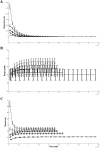The glass is half-full: overestimating the quality of a novel environment is advantageous
- PMID: 22509326
- PMCID: PMC3317990
- DOI: 10.1371/journal.pone.0034578
The glass is half-full: overestimating the quality of a novel environment is advantageous
Abstract
According to optimal foraging theory, foraging decisions are based on the forager's current estimate of the quality of its environment. However, in a novel environment, a forager does not possess information regarding the quality of the environment, and may make a decision based on a biased estimate. We show, using a simple simulation model, that when facing uncertainty in heterogeneous environments it is better to overestimate the quality of the environment (to be an "optimist") than underestimate it, as optimistic animals learn the true value of the environment faster due to higher exploration rate. Moreover, we show that when the animal has the capacity to remember the location and quality of resource patches, having a positively biased estimate of the environment leads to higher fitness gains than having an unbiased estimate, due to the benefits of exploration. Our study demonstrates how a simple model of foraging with incomplete information, derived directly from optimal foraging theory, can produce well documented complex space-use patterns of exploring animals.
Conflict of interest statement
Figures





References
-
- Egas M, Sabelis MW. Adaptive learning of host preference in a herbivorous arthropod. Ecol Lett. 2001;4:190–195.
-
- Radespiel U, Zimmermann E. The influence of familiarity, age, experience and female mate choice on pregnancies in captive grey mouse lemurs. Behaviour. 2003;140:301–318.
-
- Dukas R. Life history of learning: performance curves of honeybees in the wild. Ethology. 2008;114:1195–1200.
-
- Metzgar LH. An experimental comparison of screech owl predation on resident and transient white-footed mice (Peromyscus leucopus). J Mammal. 1967;48:387–391.
Publication types
MeSH terms
LinkOut - more resources
Full Text Sources

